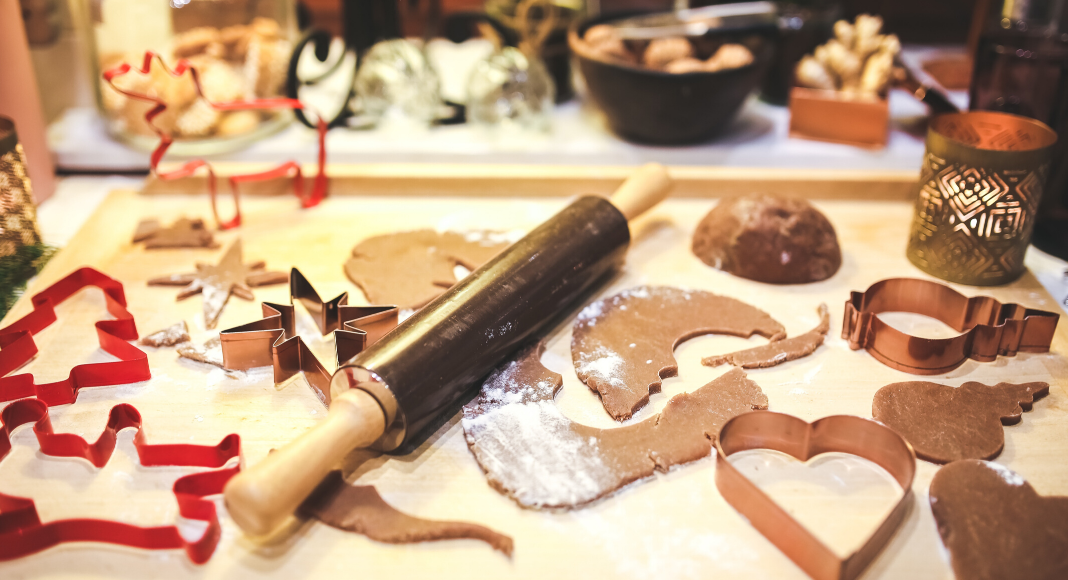Soon after changing my diet to omit gluten, my friend offered me a packaged brownie. When I asked if it had gluten, she checked the label and replied, “No, it just has flour.” This and a few other confused interactions inspired me to educate others on what it means to eat gluten-free.

It can be a little intimidating when you see “gluten-free” as the dietary restriction on your friend’s postpartum meal train. You may have wondered, what is gluten? What foods have gluten? What is a Celiac? And for the love of all things, can they still eat pasta and bread?!
The week before Christmas is designated as Gluten-Free Baking Week to bring awareness to the challenge of eating gluten-free around the holidays (and year-round).
Before I get into tips and recipes, I’ll answer those burning questions to provide a baking foundation:
- Gluten is a protein that acts as a glue to help foods maintain their shape and elasticity.
- Gluten is primarily found in wheat, barley and rye (oats are inherently gluten-free but often become contaminated with gluten, so be sure to check labels).
- Celiac disease is an autoimmune disease, and those who have it can cause damage to their small intestines by eating gluten.
- Yes! Pasta and bread are still on the table. More on that below.
I’ve eaten gluten-free for six years due to a sensitivity to the protein, not celiac disease. I love food and baking, so I was determined to still enjoy many of my favorites by tweaking recipes and finding edible substitutions. I’ve tried various flours, baking mixes, crackers, breads and pastas to find the best replacements for my favorite foods (this nursing mama needs her cookies… it’s for the baby, right?).
I’ll give you my top four tips and a few favorite recipes (hello, Christmas morning cinnamon rolls) as you head into the holidays and cook for gluten-free friends and family.
- Start with gluten-free all-purpose flour. I’ve made a lot of my favorite desserts by either replacing the flour with an all-purpose gluten-free version or finding recipes that don’t require flour. My favorite flours are Pamela’s (I like pretty much everything she makes) and Bob’s Red Mill. You’ll probably notice a difference in texture: baked goods made with gluten-free flour tend to be a little more crumbly, so small tweaks may be in order. I attempted a pumpkin roll in November, but instead of rolling it and risking it breaking, I made a four-layer cake with cream cheese frosting. My family taste-testers agreed that they couldn’t tell it was gluten-free (the ultimate compliment).
- Dense foods work best. If you’re looking for light and fluffy, you may come up disappointed. Brownies work, but pizza crust is tough (sometimes quite literally). My favorite brownie recipe is almost like fudge, and it requires a scoop of vanilla ice cream to cut the richness. But it’s amazing. The best peanut butter cookie recipe I’ve found is flourless, chewy and oh-so peanut buttery with a whopping two cups of the nut butter. And good old Betty Crocker has a decent chocolate chip cookie mix when you’re in a pinch.
- Al dente vs. goo. Many breads and pastas replace the wheat with corn and rice. Just as a pot of overcooked rice can become rubbery and goopy (technical term), the same will happen with unmonitored gluten-free pasta on the stove or bread/crackers/pretzels is exposed to too much moisture. Here are a few brands and cooking tips to ensure you don’t succumb to the goo:
-
-
- Pasta? Follow cook times to a T, test a piece to make sure the pasta isn’t past its prime, and add oil after cooking so it won’t self-adhere. My favorite pasta brands are Barilla (penne, elbow and linguini) and DeLallo (orzo).
- Lasagna? Use Tinkyada brand and slightly undercook.
- Chicken noodle soup? Skip the egg noodles and add long-grain or brown rice.
- Pie crust? Buy Pamela’s graham crackers and crunch them up for a delicious cheesecake crust, or buy Whole Foods’ frozen crust for your pumpkin pie.
- Bread? Every gluten-free eater has their favorite, but I like Three Bakers 7 Ancient Grains (find it in the frozen section, and then toast it for the best texture).
- Crackers? There are several good ones, and my go-to’s are Blue Diamond Almond Nut Thins or Kroger’s Simple Truth Multigrain Rice Crackers.
- Pancakes? Bisquick has my favorite gluten-free mix for these breakfast treats.
-
- Go for simple over complex. Yes, there are replacements for many of your favorite glutinous foods. But check labels to see what they’ve added to make up for the missing wheat, barley and rye. Are there a handful of recognizable ingredients or 27 words you’ve never heard? Is there a bunch of sugar and salt? If I really want something I’ve missed while being gluten-free, I might make an exception. But usually, if I see too many ingredients, I decide it’s not worth it.
Most importantly, here is that Christmas morning cinnamon roll recipe I mentioned. They’re so soft and oozing with icing that you’ll have smiling mouths full of cinnamon goodness at the Christmas breakfast table.
In January, I’ll post about my favorite gluten-friendly restaurants around Cincinnati and what to order. You’ll be surprised at how accommodating restaurants have become. In the meantime, enjoy stress-less gluten-free baking this holiday season.












